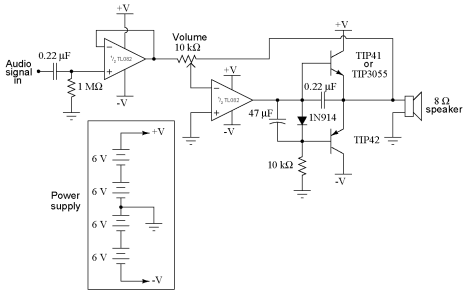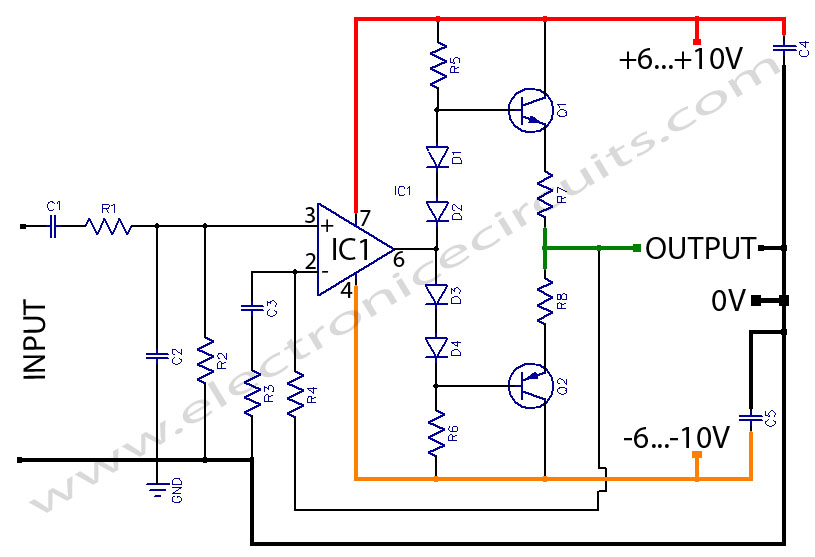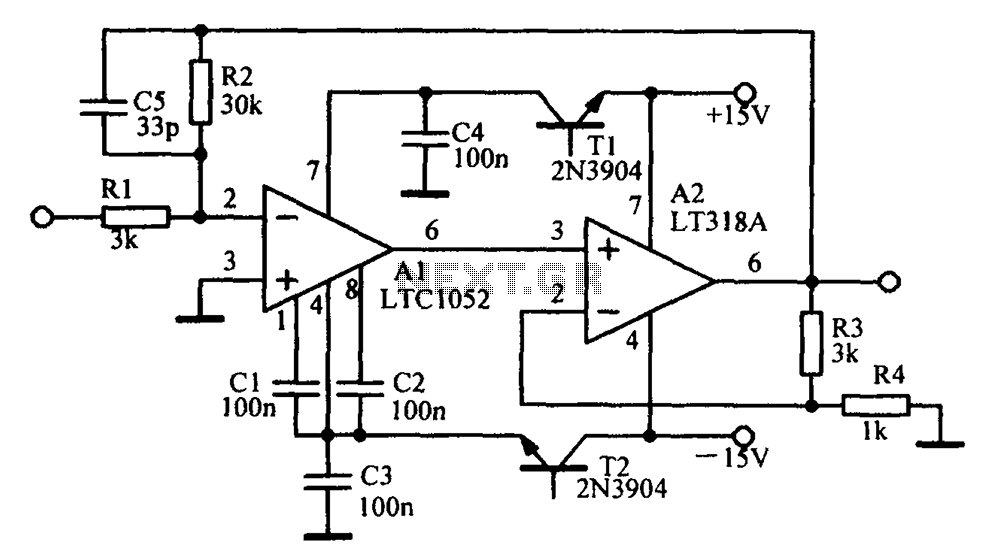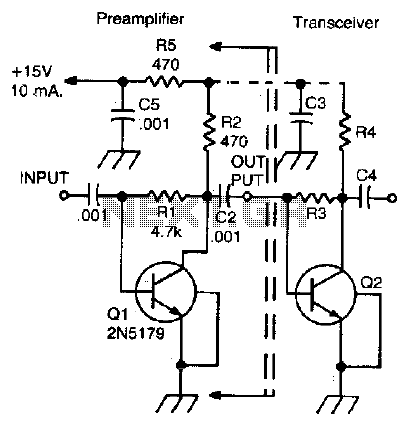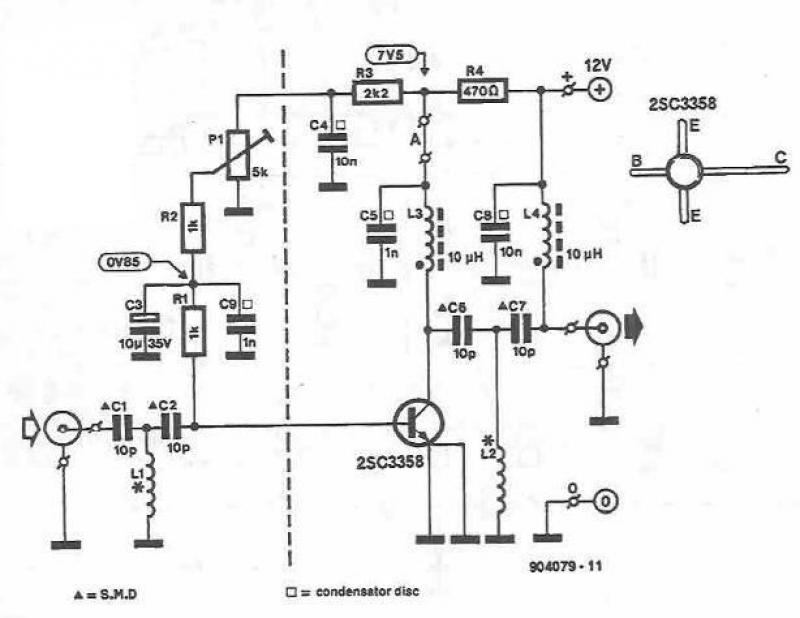
BTL amplifier composed by a single amplifier
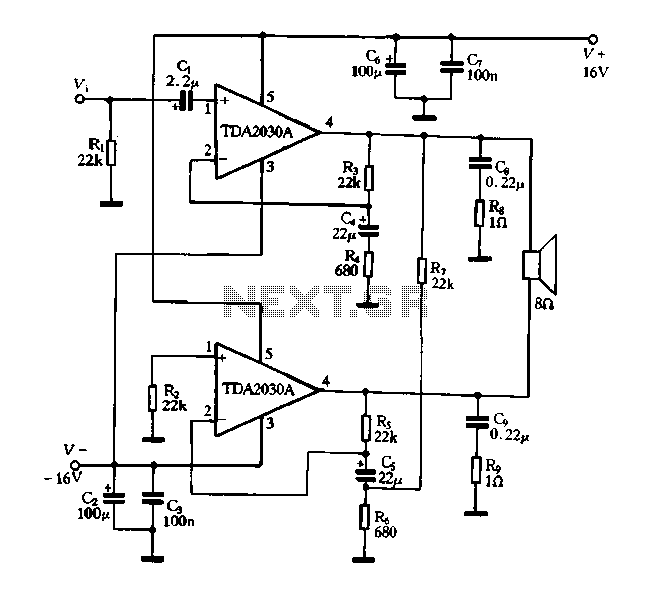
The 13TL amplifier utilizes discrete components and features a complex circuit structure. In contrast, the BTL amplifier circuit structure is simpler and generally performs well with fewer discrete components. Some integrated amplifiers, which are produced on a single integrated circuit, contain two amplifiers and are referred to as bi-amping, making them likely candidates for BTL amplifier configurations. Figure T-43 illustrates a BTL amplifier circuit composed of a single power amplifier, the TDA2030A. This circuit operates with a 16V dual power supply voltage and can deliver a maximum output power of 34W. In a single amplifier configuration, the maximum output power is 14W.
The 13TL amplifier circuit is designed to leverage discrete components to achieve specific performance characteristics, albeit with increased complexity. The BTL (Bridge-Tied Load) amplifier configuration is an efficient design that allows for higher output power while minimizing the number of components required. By employing two amplifiers in a bi-amping configuration, the BTL circuit effectively doubles the output power without necessitating additional power supply voltage, thus enhancing overall efficiency.
The TDA2030A integrated circuit serves as the core of the BTL amplifier configuration, providing robust performance with a maximum output of 34W when powered by a dual 16V supply. This makes it suitable for driving speakers in various audio applications. The circuit's design facilitates a simplified connection to the load by eliminating the need for a center tap on the power supply, allowing for a more straightforward implementation in audio systems.
In practical applications, the BTL amplifier circuit can be used in home audio systems, car audio systems, and other scenarios where high power output is required from a compact design. The dual power supply configuration ensures that the amplifier can maintain high performance across a range of operating conditions, while the discrete component approach allows for customization and optimization of the circuit to meet specific audio requirements.
Overall, the combination of discrete components and integrated circuits in the 13TL and BTL amplifier designs exemplifies modern audio engineering practices, balancing complexity with performance to deliver high-quality sound output.Discrete components 13TL amplifier, the circuit structure is complex, with an integrated power amplifier circuit of BTL amplifier circuit structure is simple, performance and q uite discrete components. Some integrated amplifier on a single integrated circuit produced two amplifier, called bi-amping, the most likely composition BTL amplifier circuit. Figure t-43 by a single power amplifier TDA2030A composed BTL amplifier circuit. This circuit 16V dual power supply voltage, output 34W maximum power. And in a single amplifier, the maximum output power of 14W
The 13TL amplifier circuit is designed to leverage discrete components to achieve specific performance characteristics, albeit with increased complexity. The BTL (Bridge-Tied Load) amplifier configuration is an efficient design that allows for higher output power while minimizing the number of components required. By employing two amplifiers in a bi-amping configuration, the BTL circuit effectively doubles the output power without necessitating additional power supply voltage, thus enhancing overall efficiency.
The TDA2030A integrated circuit serves as the core of the BTL amplifier configuration, providing robust performance with a maximum output of 34W when powered by a dual 16V supply. This makes it suitable for driving speakers in various audio applications. The circuit's design facilitates a simplified connection to the load by eliminating the need for a center tap on the power supply, allowing for a more straightforward implementation in audio systems.
In practical applications, the BTL amplifier circuit can be used in home audio systems, car audio systems, and other scenarios where high power output is required from a compact design. The dual power supply configuration ensures that the amplifier can maintain high performance across a range of operating conditions, while the discrete component approach allows for customization and optimization of the circuit to meet specific audio requirements.
Overall, the combination of discrete components and integrated circuits in the 13TL and BTL amplifier designs exemplifies modern audio engineering practices, balancing complexity with performance to deliver high-quality sound output.Discrete components 13TL amplifier, the circuit structure is complex, with an integrated power amplifier circuit of BTL amplifier circuit structure is simple, performance and q uite discrete components. Some integrated amplifier on a single integrated circuit produced two amplifier, called bi-amping, the most likely composition BTL amplifier circuit. Figure t-43 by a single power amplifier TDA2030A composed BTL amplifier circuit. This circuit 16V dual power supply voltage, output 34W maximum power. And in a single amplifier, the maximum output power of 14W
